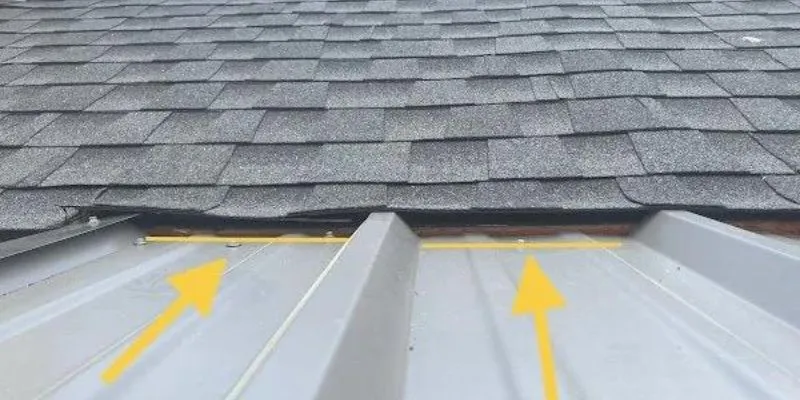Transitioning from a shingle roof to a metal roof is a significant upgrade. It’s crucial for homeowners seeking durability and longevity. This article will guide you through the shingle to metal roof transition detail, ensuring a smooth process.
Understanding the Benefits of Shingle to Metal Roofs
Switching to a metal roof offers numerous benefits:
- Durability: Metal roofs last longer than shingle roofs.
- Energy Efficiency: They reflect sunlight, reducing cooling costs.
- Low Maintenance: Less upkeep compared to shingles.
- Aesthetic Appeal: Modern and sleek look.
Preparing for the Transition
Before starting the transition, thorough preparation is essential:
- Inspection: Assess the current roof’s condition.
- Planning: Choose the right type of metal roofing.
- Budgeting: Estimate costs for materials and labor.
- Permits: Obtain necessary permits from local authorities.
Materials Needed
You’ll need the following materials for the transition:
- Metal panels
- Underlayment
- Flashing
- Fasteners
- Ridge caps
- Sealant
Step-by-Step Transition Process
Step 1: Remove Existing Shingles
Carefully remove the old shingles. Ensure the roof deck is in good condition. Repair any damage before proceeding.
Step 2: Install Underlayment
Apply a high-quality underlayment to provide an extra layer of protection. This helps prevent moisture and improves insulation.
Step 3: Set Up Flashing
Install flashing around roof penetrations, such as chimneys and vents. This prevents leaks and ensures a watertight seal.
Step 4: Attach Metal Panels
Start at the roof’s bottom edge. Secure the metal panels with the appropriate fasteners. Overlap each panel to ensure a seamless fit.
Step 5: Secure Ridge Caps
Install ridge caps at the roof’s peak. They provide additional protection against weather elements and enhance the roof’s appearance.
Step 6: Apply Sealant
Use sealant to seal any gaps and joints. This step is crucial for preventing leaks and ensuring longevity.
Comparison Table: Shingle vs. Metal Roof
| Feature | Shingle Roof | Metal Roof |
| Lifespan | 20-30 years | 50-70 years |
| Maintenance | Regular | Low |
| Energy Efficiency | Moderate | High |
| Cost | Lower upfront cost | Higher upfront cost |
| Aesthetic Options | Limited | Varied |
| Weight | Heavy | Light |
Choosing the Right Metal Roofing Material
There are various types of metal roofing materials to choose from, including:
- Steel: Durable and cost-effective.
- Aluminum: Lightweight and resistant to corrosion.
- Copper: Offers a unique aesthetic and longevity.
- Zinc: Highly durable and environmentally friendly.
Each material has its own advantages, so consider your specific needs and preferences when making a choice.
Coating and Finishes
Metal roofs come with different coatings and finishes to enhance their durability and appearance. Common options include:
- Galvanized Coating: Provides rust protection.
- Painted Finish: Available in various colors to match your home’s aesthetic.
- Stone-Coated: Combines the durability of metal with the look of traditional shingles.
Maintenance Tips for Your New Metal Roof
Regular Inspections
Schedule regular inspections to catch any potential issues early. Look for signs of wear, loose fasteners, or damaged panels. Addressing problems promptly can extend the lifespan of your roof.
Cleaning and Debris Removal
Keep your metal roof clean by removing debris such as leaves, branches, and dirt. This prevents moisture buildup and reduces the risk of corrosion. A simple rinse with water and a soft brush can help maintain its appearance.
Addressing Minor Repairs
If you notice minor damages, such as small dents or scratches, repair them promptly. Use appropriate sealants and touch-up paint to prevent further damage and maintain the roof’s integrity.
Environmental Benefits of Metal Roofs
Energy Efficiency
Metal roofs are highly reflective, reducing the amount of heat absorbed by your home. This leads to lower cooling costs and increased energy efficiency. Many metal roofs also qualify for energy tax credits, adding to their financial benefits.
Sustainability
Metal roofing materials are often made from recycled content and are fully recyclable at the end of their lifespan. This makes them an environmentally friendly choice compared to traditional shingles, which contribute to landfill waste.
What Do You Put Between Shingles and Metal Roofing?
Between shingles and metal roofing, you should use a waterproof underlayment. This underlayment acts as a barrier to protect against moisture, ice, and wind-driven rain. It also helps in preventing leaks and enhances the overall durability of the roofing system. Common materials for underlayment include synthetic underlayment, felt paper, and peel-and-stick membranes.
Can You Tie a Shingle Roof into a Metal Roof?
Yes, you can tie a shingle roof into a metal roof. This process involves:
- Installing Flashing: Use metal flashing to connect the shingle and metal roofing sections, ensuring a watertight seal.
- Overlapping Materials: Overlap the shingles onto the metal roof and secure them properly.
- Using Sealants: Apply appropriate sealants at the transition points to prevent leaks.
- Securing Fasteners: Ensure all fasteners are properly installed and sealed to maintain the integrity of the roofing system.
What Is a Transition on a Metal Roof?
A transition on a metal roof refers to the point where two different roofing materials or planes meet. This could be a transition from a metal roof to a shingle roof, from one slope to another, or from a roof to a wall. Transitions require careful detailing to ensure they are watertight and durable. This usually involves using specialized flashing, sealants, and fasteners to create a seamless and weather-resistant connection.
Choose Hasid On The Roof Florida
At Hasid On The Roof Florida, we are experts in roofing transitions. We understand the intricacies of moving from shingle to metal roofs. Our team in Miami, FL, is dedicated to providing top-notch services. We use high-quality materials and ensure meticulous attention to detail.
If you’re considering a roofing upgrade, trust us to deliver exceptional results. Contact us today for a consultation. We are here to make your roofing transition smooth and hassle-free.

